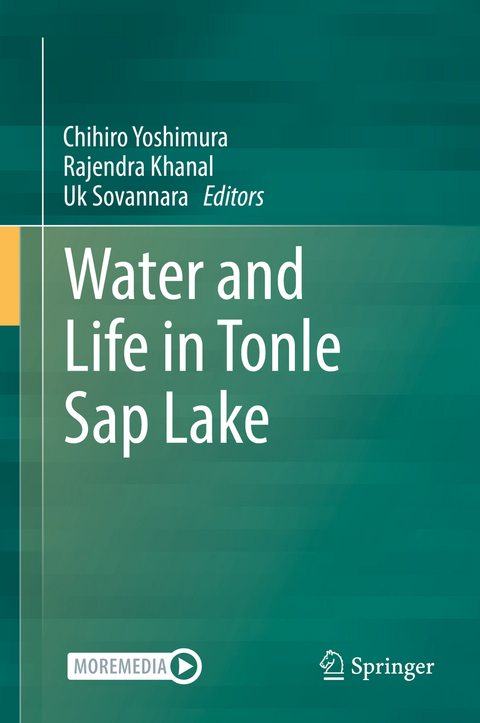
Water and Life in Tonle Sap Lake
Springer Verlag, Singapore
978-981-16-6631-5 (ISBN)
This book serves as a guidebook to multiple audiences, including professionals and academicians. It is beneficial to the university students and lecturers, researchers, freelancers, and policymakers in analyzing, interpreting, and taking action for the environmental conservation of the lake environment. In addition, this is the first comprehensive book on evidence-based research and policy-relevant experience and knowledge about Tonle Sap Lake. For instance, the content will assist the policymakers and researchers in setting management policies and practices, especially for large shallow lakes and developing countries. It can also be used as a textbook in environmental science and engineering at undergraduate and graduate levels worldwide in understanding and synthesizing new research directions relevant to the water environment.
Rajendra KHANAL Tokyo Institute of Technology, Japan Chihiro YOSHIMURA Tokyo Institute of Technology, Japan Uk Sovannara Tokyo Institute of Technology, Japan
Chapter1. Introduction.- Chapter 2. Lake and Livelihoods: Threats to Their Sustainability.- Chapter 3. Fish Resources: Its Importance and Challenges.- Chapter 4. Governance and Human–Nature Relation.- Chapter 5. Zoning and Its Impacts on Governance.- Chapter 6. Climate and Rainfall.- Chapter 7. Inundation and Water Surface Temperature: Satellite-Based Observation.- Chapter 8. Hydrology of the Inflow River Basins.- Chapter 9. Groundwater and Surface Water Exchange in the Lake Basin.- Chapter 10. Improvement of a Hydrological Model Performance by Satellite Rainfall Product.- Chapter 11. Flood Pulse and Water Level.- Chapter 12. Discharge Measurement and Hydraulic Characteristics in the Tonle Sap River.- Chapter 13. Mathematics and Numerics of a Two-Dimensional Local Inertial Equation.- Chapter 14. Numerical Simulation of Hydrodynamics Using the Two-Dimensional Local Inertial Equation.- Chapter 15. Hydrodynamic Properties Characterized by Two-Dimensional Hydraulic Simulation.- Chapter 16.Flow Regime of a Floating Village Using a Three-Dimensional Hydraulic Model.- Chapter 17. Sediment and Suspended Solids: Spatiotemporal Dynamics.- Chapter 18. Total Suspended Solid Dynamics Revealed by Long-term Satellite Image Analysis.- Chapter 19. Sediment Resuspension and its Relation to Flood Pulse.- Chapter 20. Sediment Loads from Tonle Sap Lake Tributaries.- Chapter 21. Physico-Chemical Properties of Suspended Solids and Sediment.- Chapter 22. Basin-wide Distribution of Water Quality.- Chapter 23. Basic Physicochemical Water Quality—Spatiotemporal Distribution.- Chapter 24. Nutrient Availability and Phosphorus Dynamics.- Chapter 25. Phosphorus Dynamics—Modeling and Simulation.- Chapter 26. Chemistry of Groundwater in the Floodplain.- Chapter 27. Bacterial Communities: Their Dynamics and Interactions with Physicochemical Factors.- Chapter 28. Microcystin Production and Oxidative Stress.- Chapter 29. Multidrug-ResistantBacteria.- Chapter 30. Antibiotic Resistance of Intestinal Bacteria.- Chapter 31. Primary Production.- Chapter 32. Flooded Forests.- Chapter 33. Aquatic Fauna and Aquaculture.- Chapter 34. Waterbirds.- Chapter 35. Chemical Analysis of Heavy Metals and Pesticides: Pretreatment.- Chapter 36. Heavy Metals.- Chapter 37. Residual Pesticides.- Chapter 38. Heavy Metal Accumulation in Fish.- Chapter 39. Pesticide Residues in Vegetables from Provinces around Tonle Sap Lake.- Chapter 40. Water Use, Sanitation, and Health Conditions in Villages on/around the Lake.- Chapter 41. Health Risk Assessment of a Floating Village Based on a Three-Dimensional Hydraulic Model.- Chapter 42. Virus Removal by Poly Aluminum Chloride and Calcium Hypochlorite.- Chapter 43. Impact of Climate Change on the Hydrological Regime of Tonle Sap Lake.- Chapter 44. Projection of Land Use and Land Cover in the Lake Basin.- Chapter 45. Permissible Phosphorus Load.- Chapter 46. Effects of Environmental Factors on Eutrophication.- Chapter 47. Application of a Sorbent Derived from Lake Sediment and Bivalve Shells for Phosphorus Removal.- Chapter 48. Management of Flooded Forests and Fish Resources.- Chapter 49. Transdisciplinary Research Collaboration for Environmental Conservation.- Chapter 50. Recommendations for Further Research and Environmental Management.
| Erscheinungsdatum | 30.06.2022 |
|---|---|
| Zusatzinfo | XVIII, 525 p. With online files/update. |
| Verlagsort | Singapore |
| Sprache | englisch |
| Maße | 155 x 235 mm |
| Themenwelt | Sachbuch/Ratgeber ► Natur / Technik ► Natur / Ökologie |
| Naturwissenschaften ► Biologie ► Ökologie / Naturschutz | |
| Naturwissenschaften ► Geowissenschaften ► Hydrologie / Ozeanografie | |
| Technik ► Umwelttechnik / Biotechnologie | |
| Schlagworte | Co-Design • environmental conservation • Evidence-based discussion • Flood Simulation • Lake environment • Pathogens • Tonle sap basin |
| ISBN-10 | 981-16-6631-8 / 9811666318 |
| ISBN-13 | 978-981-16-6631-5 / 9789811666315 |
| Zustand | Neuware |
| Informationen gemäß Produktsicherheitsverordnung (GPSR) | |
| Haben Sie eine Frage zum Produkt? |
aus dem Bereich


